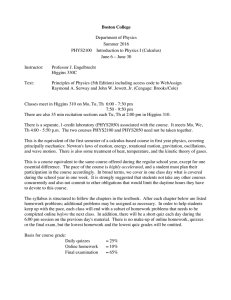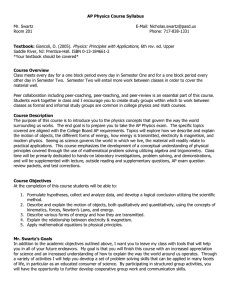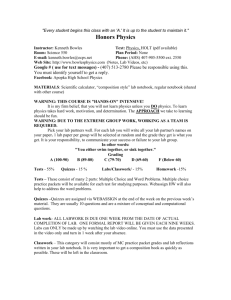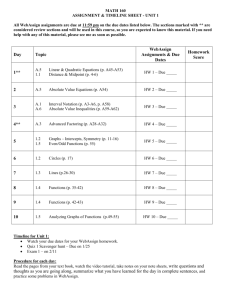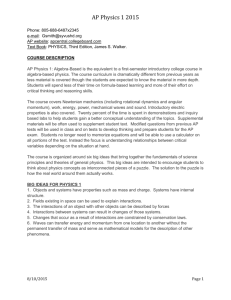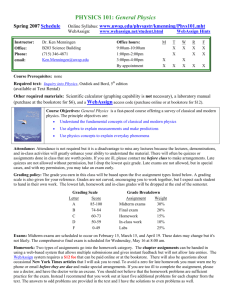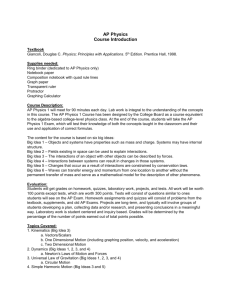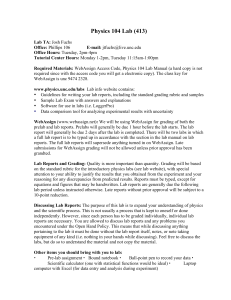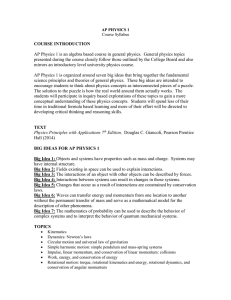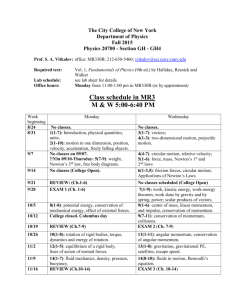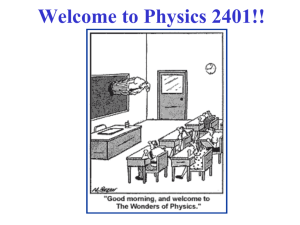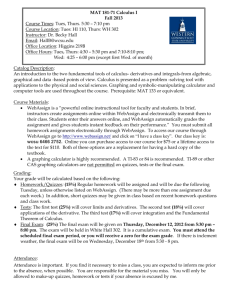AP® Physics C – Mechanics: Syllabus
advertisement
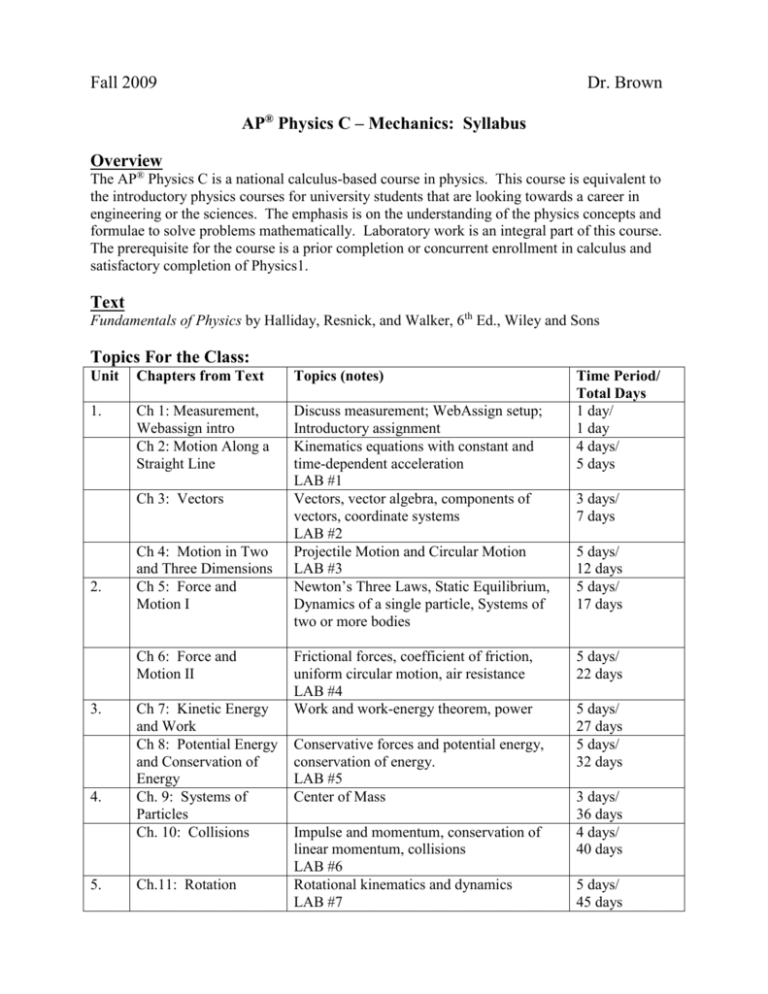
Fall 2009 Dr. Brown AP® Physics C – Mechanics: Syllabus Overview The AP® Physics C is a national calculus-based course in physics. This course is equivalent to the introductory physics courses for university students that are looking towards a career in engineering or the sciences. The emphasis is on the understanding of the physics concepts and formulae to solve problems mathematically. Laboratory work is an integral part of this course. The prerequisite for the course is a prior completion or concurrent enrollment in calculus and satisfactory completion of Physics1. Text Fundamentals of Physics by Halliday, Resnick, and Walker, 6th Ed., Wiley and Sons Topics For the Class: Unit Chapters from Text Topics (notes) 1. Ch 1: Measurement, Webassign intro Ch 2: Motion Along a Straight Line Discuss measurement; WebAssign setup; Introductory assignment Kinematics equations with constant and time-dependent acceleration LAB #1 Vectors, vector algebra, components of vectors, coordinate systems LAB #2 Projectile Motion and Circular Motion LAB #3 Newton’s Three Laws, Static Equilibrium, Dynamics of a single particle, Systems of two or more bodies Ch 3: Vectors 2. Ch 4: Motion in Two and Three Dimensions Ch 5: Force and Motion I Ch 6: Force and Motion II 3. 4. 5. Ch 7: Kinetic Energy and Work Ch 8: Potential Energy and Conservation of Energy Ch. 9: Systems of Particles Ch. 10: Collisions Ch.11: Rotation Frictional forces, coefficient of friction, uniform circular motion, air resistance LAB #4 Work and work-energy theorem, power Conservative forces and potential energy, conservation of energy. LAB #5 Center of Mass Impulse and momentum, conservation of linear momentum, collisions LAB #6 Rotational kinematics and dynamics LAB #7 Time Period/ Total Days 1 day/ 1 day 4 days/ 5 days 3 days/ 7 days 5 days/ 12 days 5 days/ 17 days 5 days/ 22 days 5 days/ 27 days 5 days/ 32 days 3 days/ 36 days 4 days/ 40 days 5 days/ 45 days Ch. 12: Rolling, Torque and Angular Momentum 6. Ch. 13: Equilibrium and Elasticity Ch. 14: Gravitation Ch. 16: Oscillations Angular momentum (point particles and extended bodies, including rotational inertia) and its conservation, torque LAB #8 Applications of Newton’s 1st Law and rotational statics Newton’s law of gravity, circular and general orbits of planets and satellites, Kepler’s Laws LAB #9 Simple harmonic motion (dynamics and energy relationships), mass on a spring, Pendulum and other oscillations LAB #10 5 days/ 50 days 4 days/ 54 days 4 days/ 58 days 4 days/ 62 days A hands-on, end-of-semester project will be assigned to apply many of the concepts from the course. Weekly Class Schedule The general set-up for each chapter will be approximately the same and usually last 1 week. Students are expected to have read each chapter by the first day of discussion for that chapter. The general breakdown for the week is as follows: Day 1: The teacher will review the concepts and ideas for the chapter doing example problems and demonstrations. Day 2: The teacher will finish discussion of concepts and ideas. The students in the class will do problems in small groups and will answer Questions at the end of the chapter. Day 3/4: Students are guided in discussions to come up with solutions to problems from the book. Time to work on/ discuss in groups the homework questions. Guided help provided by the teacher in solving homework problems. Students lead white-boarding presentations to the class of answers to “Questions” and solutions to homework problems. Day 5: Hands-on lab for the chapter, with lab write-up to be completed. A test or quiz will generally be given at the conclusion of each unit. Grading Policy Students will receive a mid-term grade (1st marking period), a second marking period grade, and a final exam grade which is worth 20% of the course grade. Marking period grades will be based on the following criteria: Tests/ quizzes 50% Homework 30% Labs 20% Tests/ Quizzes Tests will be given at the end of units 2, 4, and 6. A quiz may be given at the end of units 1, 3, and 5. The tests and quizzes will be similar to the homework in content, but may apply these ideas in different ways. This being the case, you should understand how to apply the concepts to many different types of problems. Take note that all content that has been covered could appear on a test or quiz. This is how the AP Exam works – it uses an application of all your understanding on one question. This is what makes the AP Exam so difficult – a very good understanding of many topics applied to one question. Quizzes will consist of multiple choice questions and tests will have MC as well as math-based open ended questions very similar to the AP Exam. Homework This class is about understanding physics and how to answer physics questions. In order to become proficient in answering questions you need to understand the concepts and how to apply the concepts mathematically. In order to do this you need practice. You will have a significant amount of homework. This practice is the key to your success to the whole course. We will be using webassign.net to hand in your weekly/chapter assignments. This will (hopefully) help ensure your commitment to this course. You will have to submit your answers to all the homework questions online (generally by 11:59 PM on the date they are due). You will generally have four attempts to answer the question before you can not attempt to answer any further. This should give you a reasonable chance to get it correct even if you do not get it correct at first. WebAssign provides different numbers for each question to every student, so that your question will be worded in the same way- except for the numbers. Because of this, every student will have a different answer to each question. You will also need to write a formal copy of each of the chapter homework sets. This formal copy will be graded as part of the chapter homework assignment and will be due on the class day following the due date for the WebAssign. This formal copy for the solutions is extremely important for you to complete and have so you can re-inforce your problem solving and review the material for the exams. Labs Each of the labs will require a written report (must be legibly written or type-written) which includes: Purpose: Presentation of the purpose of the lab and a formulation of an hypothesis which is based on the presented problem as discussed in class. Method: Design or methodology of an experiment based on in-class discussion. Data: Collection of data and observations. Calculations: Calculations using the collected data. Conclusion: Conclusions about how well the hypothesis held up based on the experiment and error analysis of the data. You will keep your lab reports in a portfolio which will be graded periodically.
